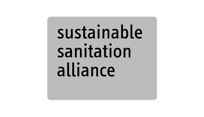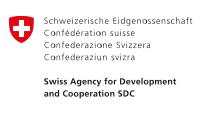Composting involves the controlled aerobic decomposition of organic waste that results in a soil-like material called compost. The process occurs because of microbial activity in the presence of oxygen. The agricultural use U.5 of compost improves soil structure and increases the availability of nutrients in the soil.

The composting of organic matter is created by a diverse population of microorganisms and invertebrates. Basic parameters including moisture levels, carbon-nitrogen (C:N) ratio and aeration are managed, controlled and adjusted to achieve fast degradation and good compost quality. Co-composting refers to the adding of faecal sludge to the process. A typical characteristic of a well-functioning composting process is a high-temperature phase (50-70°C). The high temperature contributes to the sterilisation of the material, partially eliminating pathogens and weed seeds. Under ideal operating conditions, compost is produced within three months. When conditions are sub-optimal, the process may be slower or even fail. The main output is compost, a stable dark brown, soil-like material with an earthy smell. Although the composting process is simple, a well-functioning facility requires careful planning, design and operation to avoid failure.
Design Considerations
Two commonly used composting methods are (1) open windrows and (2) in-vessel (bin or box). In open windrows, organic waste is piled into heaps called windrows and left to compost. In-vessel composting uses vessels, bins or boxes to contain the waste during the process. Rotating vessels can also be used to improve aeration and accelerate the decomposition process. A key component of a composting facility’s design is space. Space is needed for waste sorting and preparation of the waste; for the composting windrows or vessels; for screening the finished compost; storage of the final compost; for staff facilities and for a green buffer surrounding the location. Ideally, the facility (at least the area of the composting windrow or vessels) should be covered to better control moisture. The facility should be fenced to prevent animals from entering; the site should be as close as possible to where the organic waste is generated to minimise transport effort and cost. Robust grinders can shred large pieces of organic waste before composting. Windrows should be at least 1.5 m high and wide. In colder climates windrows of 2 m height and 2 m width are recommended. The composting pad (the ground surface where the windrows are located) should be sealed to avoid leachate infiltration and slightly sloped to collect the leachate. The leachate can then be recirculated into the windrows or treated before discharge.
Materials
Composting facilities can be constructed with locally available materials. The compost pad can be made of concrete or well-compressed clay. A cover/roof and fencing may be made from local materials such as bamboo, grass matting, wood, plastic or metal sheets. Water may be required depending on the climate to maintain compost moisture levels. Prefabricated composting vessels of different sizes are available on the market. Mechanised equipment to turn the compost, robust grinders for shredding large pieces of input material and rotating or shaking sieves can reduce manual labour, ensure a more homogenous end product and optimise the process.
Applicability
Composting can be carried out at different scales, using a variety of equipment and infrastructure and different levels of mechanisation. For small-scale home composting, bins are most frequently used. Bins rely on a passive aeration process. Medium and large-scale composting using open windrows, bins or in-vessels, typically rely on regular turning or active aeration using appropriate equipment. Managing a composting facility is complex. Its staff are required to operate the facility and monitor treatment efficiency. Consequently, this technology is unlikely to be practical in the acute response phase. However, it can be a viable option in the stabilisation and recovery phases. Experience has shown that composting facilities operate best when they are established as a business with compost as the marketable product that generates revenue to support cost recovery (although compost sales cannot be expected to cover the full cost of the service).
Operation and Maintenance
The operation requirements for composting facilities are high. Staff should carefully track turning schedules, temperature and maturing times to ensure pathogen removal and high-quality treatment. Organic waste must first be sorted so it is free of non-organic materials. Depending on the size of the composting facility, a compost windrow is turned with a front-end loader, or by hand using a pitchfork or shovel.
Health and Safety
Health risks can be minimised if workers adopt basic precautions and hygienic practices and wear personal protective equipment. Workers should wear masks to protect them from dust and fungi spores. If pathogen-containing input materials are used, special handling precautions must be taken X.4. To ensure the safety of the final compost, the World Health Organization (WHO) recommends that temperatures of 55–60 °C should be reached for at least one week throughout the mix.
Costs
The cost of building a composting facility varies depending on the method chosen, the cost of local materials and whether machinery, such as aerators and grinders, is included in the design. The main costs are the overall operation requirements, including transport and the supply of organic solid waste and labour.
Social Considerations
When composting is not properly controlled, it may attract rodents and flies. If too wet, anaerobic degradation can occur (i.e. the organic waste starts to rot) generating bad smells and greenhouse gases. Such emissions from the facility could decrease the social acceptance of composting. If compost is sold on the market, ensuring that the compost product conforms to local standards and regulations is a prerequisite X.1. Ensuring a market and use for the composting end product greatly increases the sustainability of a composting facility X.5.
Key Decision Criteria
Input Products
Organic Garden/Wood Waste
Organic Food/Kitchen Waste
Output Products
Compost
Response Phase
Application Level
Management Level
Space Required
high,medium
Technical Complexity
low
Objectives & Key Features
Compost production, nutrient recycling, waste diversion from disposal and GHG mitigation
Strength & Weakness
- Low-tech solution for organic waste management
- Proven effective treatment with a valuable end product
- Requires a large, well-located land area
- Long treatment times
- Can emit a smell and attract animals if not managed well






